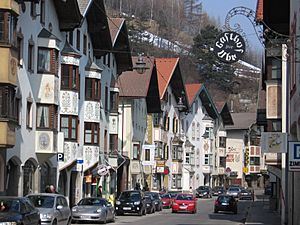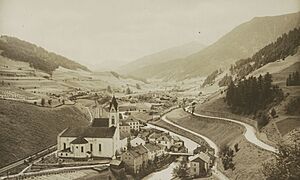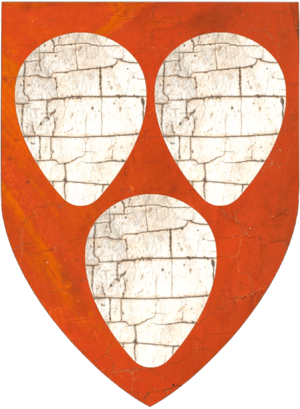Matrei am Brenner facts for kids
Quick facts for kids
Matrei am Brenner
|
||
|---|---|---|
 |
||
|
||
| Country | Austria | |
| State | Tyrol | |
| District | Innsbruck Land | |
| Area | ||
| • Total | 0.36 km2 (0.14 sq mi) | |
| Elevation | 992 m (3,255 ft) | |
| Time zone | UTC+1 (CET) | |
| • Summer (DST) | UTC+2 (CEST) | |
| Postal code |
6143
|
|
| Area code | 05273 | |
| Vehicle registration | IL | |
| Website | www.matrei-brenner.tirol.gv.at | |
Matrei am Brenner is a small and important village in Austria, located about 17 kilometers (10 miles) south of the city of Innsbruck. It sits at 992 meters (3,255 feet) above sea level. The Sill river flows right through the village.
Matrei has always been a key stop for trade and travel. In 2022, two nearby villages, Pfons and Mühlbachl, joined with Matrei. Today, the combined village has about 3,500 people living there.
Contents
Geography of Matrei
Matrei am Brenner is found in the southern part of the Innsbruck Land area. Near the village of Mühlbachl, the main road splits. One path follows the Sill river north towards Innsbruck.
The other path goes along the eastern side of the river. This route is longer and goes through places like Patsch, Lans, and Ampass, leading to Hall in Tirol. Historically, this was a significant path for important travelers.
History of Matrei am Brenner
People have lived in the Matrei area for a very long time. Signs show that people were here during the late Bronze Age (around 1200 BC). There are also clues from the Hallstatt culture, an early Iron Age culture.
Ancient Discoveries and Roman Times
In 1964, workers found about a hundred urns (pots used to hold ashes) while working at a place called "Gasthof Heisenstecken." This discovery showed how old the settlements in the area are.
Around 200 AD, the Romans built a rest stop here. They called it "locus Matreium." This stop was part of their important road system, as shown on an old Roman map called the Tabula Peutingeriana.
Medieval Growth and Market Status
By 995 AD, the village was known as "Matereia." In 1251, Matrei was given the special status of a "Commune Market." This meant it became an important trading center.
In 1497, the Diocese of Brixen (a church district) set up a special court in Matrei. This court handled local legal matters until 1810. After that, its duties moved to a court in Steinach am Brenner.
Life in the Market Village
The village was built around its main road, with many inns and workshops. These places served travelers and traders. In 1447, a couple named Hans Gunther and his wife opened a hospital. Its goal was to help sick travelers passing through.
During the War of the Fifth Coalition in 1809, many local people from Matrei joined the fight. Important figures like Josepf Rapp, who advised the famous Tyrolean leader Andreas Hofer, and Joseph Eisenstecken, a commander of the local militia (called Schützen), were from here.
Challenges and Rebuilding
Matrei's importance as a travel stop changed when the Brenner Railway opened. Trains started carrying goods and people, and less traffic went directly through the village.
The village faced difficult times. In 1914, a big fire destroyed many houses. During World War II, Matrei was bombed heavily because of the important railway line that ran through it. One bombing on March 22, 1945, caused 48 deaths. After the war, the people of Matrei rebuilt their village, using traditional building methods.
Population Changes
| Historical population | ||
|---|---|---|
| Year | Pop. | ±% |
| 1869 | 523 | — |
| 1880 | 539 | +3.1% |
| 1890 | 499 | −7.4% |
| 1900 | 576 | +15.4% |
| 1910 | 718 | +24.7% |
| 1923 | 589 | −18.0% |
| 1934 | 758 | +28.7% |
| 1939 | 744 | −1.8% |
| 1951 | 813 | +9.3% |
| 1961 | 954 | +17.3% |
| 1971 | 1,107 | +16.0% |
| 1981 | 1,017 | −8.1% |
| 1991 | 999 | −1.8% |
| 2001 | 998 | −0.1% |
| 2011 | 902 | −9.6% |
Important Sights and Churches
Matrei am Brenner is home to several historic and beautiful churches.
Pfarrkirche Maria Himmelfahrt
This is the main parish church, dedicated to "Our Lady." It was first built in 1311 in the Romanesque style. Later, in 1754, it was changed to the more decorative Baroque style. Joseph Adam Mölk painted the beautiful frescos inside.
The church holds a special image called "Our Lord in pain," which is believed to be miraculous. The church was restored in 1995. It is located across the Sill river, in the area that is now part of Pfons.
Church of the Holy Spirit
Also known as "Spitalskirche" (Hospital Church), this church is in the southern part of Matrei, right along the main street. It was built in 1646 and has been rebuilt several times, most recently in 2000.
Johanneskirche - Taufkirche
This church serves as the Baptistery (where baptisms take place) for the Parish. It was first mentioned in documents in 1284. In 1509, Niklas Thuring worked on it, turning it into a beautiful example of late Gothic architecture.
Shrine Maria Waldrast
"Maria Waldrast" is a special sanctuary located high up in a side valley. It sits at 1638 meters (5,374 feet) above sea level, below the Waldraster Jöchl mountain.
The Story of Maria Waldrast
The story of the shrine began in 1392. It is said that an angel caused a wooden statue of Mary, the mother of Christ, to appear in a larch tree on Serles Mountain. Two shepherd boys first saw the statue and told the farmers in the valley. The statue was then moved to the village of Matrei.
A woodcutter living nearby had a dream where a voice told him to build a chapel for Mary to protect the statue. He wasn't sure at first, but after three nights, the voice convinced him. In his sleep, he was shown exactly where the chapel should be built. He was also told to ask kind local people for money to help build it.
The woodcutter told his priest about his experience. The priest then sent him to the Bishop of Brixen. Before St. Pankratius's day in 1409, the Bishop gave permission for the chapel to be built. The church was finished in 1429 and officially blessed in 1465. Today, the Sanctuary is part of the Servants of Mary Monastery.
See also
 In Spanish: Matrei am Brenner para niños
In Spanish: Matrei am Brenner para niños





